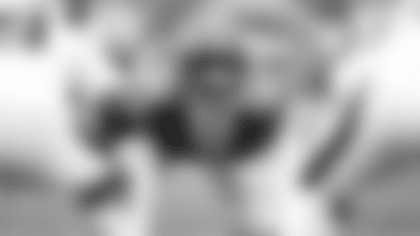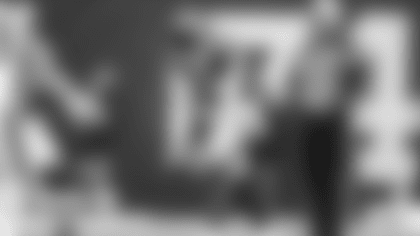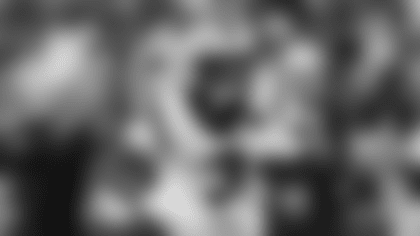Transcript of head coach Eric Mangini's news conference with the New York Jets media before Wednesday's OTA practice:
Some housekeeping: We signed Musa Smith. With Vernon Gholston, the first day he's going to be allowed in here is June 6. That's when he'll be back. I keep in touch with him, keep him current. But that's the first time he'll actually be able to participate in anything with the team and actually physically be in the building.
With OTAs, moving on with the installation, it's our second set of installations. One of the things that we're trying to do is incorporate all the situations into the practice. That's one of the things I talked to the players a lot about this morning, putting all the plays into context. We can go out, we can run the plays, we can do the things that are on the script, but you have to put those plays into context.
Is it the first play of the series? Is it second-and-one? Is it second-and-long? Is it third-and-short where you have your got-to-have-it plays? Is it third-and-long? Is it backed up? What are they going to do when they're backed up on their own 1-, 2-yard line? What are they going to do in the four-minute offense? What's their philosophy there?
It's so important as you practice and as you get ready, to do more than just run plays, to do more than just run assignments. It's doing all that, which is extremely important, but then understanding what's happening in the game and how that relates to what we're doing.
The other thing I talk to them about all the time is understanding the "why." Why are we running this defense? Why are we running this certain offensive play? Because you're going to go through the week, you're going to script looks against it, and it may not be that look. But if you understand why we're doing it, what we're trying to get done with that play, when things change, you can solve those problems, you can sort it out.
So those are two big elements of learning that we spend a lot of time with, and it starts in the spring and it's constantly being reinforced to have that situational awareness. For example, if it's a four-minute drive and it's 2:02 left in the game and you drop back. Now normally you drop back to pass on a four-minute drive, you take the sack, give up the 45 seconds.
But now the clock is going to stop no matter what, so you can actually throw the ball and take a chance there. You don't have the same risk/reward. You'd be surprised how many times people get that confused. At 2:02, you take the sack, now you're dead. There is no way for them to stop the clock. The guy throws it away, throws it out of bounds, you give them back 45 seconds. So, it's the little things.
It happened two years ago against Indy. We spent time on "P-and-10," the first play of the drive, a take-a-big-shot-now play for them. We hammered it, hammered it, hammered it, and sure enough, P-and- 10, we go back in our defense, we get sucked up by the play action, they hit a 40-yard pass. There was no context there. There was no anticipation within the course of the defense.
Same thing with Leon Washington's play, the shovel pass for a touchdown last year against the Dolphins. Talked about that a lot, how they're going to be up the field rushing, what the offensive line had to do, why we're running the play. That was a good example of it being well-executed and everybody understanding what to anticipate based on the situation.
So that's what we do with our day [smiles]. That's the long explanation of what we do with our day.
On how the no-forceout rule will affect players and strategy this year …
I think those plays that happen along the sideline, it's really hard as a defensive back or receiver to really think about the rule at that point. I don't think it will affect it very much. It will affect how they rule whether the guy's in or not in, but I don't think it's necessarily going to affect the defensive back and the wide receiver very much in that split-second on the sideline in terms of changing some philosophical approach.
On why the Jets signed Musa Smith …
Musa is a guy that we've looked at and where he brings value and flexibility is on special teams. He's done a lot on special teams over the course of his career. He's another guy you have some flexibility with, whether you want to play him at running back or fullback. And he has added depth to the special teams competition.
You're always stressing that to the players. You're not just competing against the guys at your spot, you're competing against guys at other spots for those last few roster slots. Sometimes it's very easy for a defensive back to say, "I'm the fifth corner, I'm competing with No. 6." That's not really true. You're the fifth corner, but you're competing with the fourth or fifth running back, you're competing with however many linebackers you keep. It's not letting them lose sight of the fact that it's a cross-team competition and we're going to keep the best teams players we have or we can have.
On if there is any concern about Vernon Gholston being behind …
You'd love to have him here, but there's nothing we can do about it. The thing we can control is calling him, getting him the information, reviewing the information. We have a pretty good system in place there for keeping him up to date and talking to him as much as we can. It's not the same as being here. It's really the best that we can do based on the way the rules are set up. So it's not ideal for him, for us, for anybody. But everybody's under the same rules, so you just operate that way.
On if the Jets are looking at OLB Rosevelt Colvin …
We talk about all different guys, Mike Tannenbaum and I are always going through the guys that are on street, the guys that could be available to add depth. Whether it's Rosey or anybody else, we go through that and we'll talk to a lot of different players, see where they are. Some of it's a function of immediate interest, some of it's a function of prepping if something's just happened. So it's not uncommon for us to do that.
On if the Jets have worked Colvin out …
No, we haven't.
On if Colvin was in New England when he was there …
Yes. He came in when I was there, made the transition to outside linebacker. He did a good job. It took a little time, like it does with a lot of guys making the switch. His mom makes really good cakes, that I can tell you. She takes orders and makes a ton of them. Food flexibility, always good for the head coach [smiles].
On how TE Bubba Franks is transitioning …
Bubba is doing a nice job. He was in one system for his whole career, now he's coming into this system. I think he's doing a good job with the information, with the different spots we've asked him to play. He got a lot of reps, which is positive. Anytime you can come into a situation, get those reps, work with the guys, I think that always helps you move forward. He'll be in a much better position when we go to training camp to be in the best spot possible to continue to compete.
On if Alan Faneca has become a mentor for the younger O-linemen …
Alan has done a lot of good things in terms of meeting with that group. With him, with Bill [Callahan], with Damien [Woody], with all the new guys that are in there, they're all getting used to each other, they're all working through those things together.
We have some new line calls, so it's actually a positive with Bill being here because with the new line calls, Nick [Mangold] and Brick [D'Brickashaw Ferguson] and Alan and Brandon [Moore] and Damien are all learning that stuff together. So actually, it's a positive experience because they're going through the same thing even though they've all kind of gotten here different ways.
On if it is difficult for a line to come together when there have been so many changes …
The key thing is how well everybody communicates. It doesn't matter who's there or where they came from or how long they've been there. If guys are good communicators, then cohesiveness happens pretty quickly. That's the same thing as a couple of examples defensively yesterday where half the group was running one check, the other half was running another check. A lot of that was a function of the offensive shift, the quick motion, that adjustment.
You hate to see that, but they're good to teach off of because it's another example of "Here it is." The front is running this, the back seven running this. That's the worst-case scenario. You'd all rather be wrong together because there's integrity there in the defense.
On how rookie free agent OL Shawn McMackin is doing …
I'm sure he's swimming quite a bit, like all these guys are. Every day a new layer gets thrown on. The nice thing is the rookies tend to become a very cohesive group. They do a lot of stuff not just in the building but when they get together in the evening at the hotel. They'll meet just as an offense, the offensive group, the defensive group, go through that day's practice, and go through the next day's installation.
They get some extra time with the coaches. The young coaches spend a lot of time in the morning. It gives them a better chance to get better at coaching. It gives the younger players some more one-on-one, a higher teacher /student ratio. They're working on it, but it's volumes of stuff.
On if Kellen Clemens has surprised him so far …
Some of those things you're not going to see until the games unfold, whether it's heavy pressure, whether it's situation awareness. You do the best you can to simulate that stuff, but you just can't simulate until it happens.
I thought he made some really nice throws the other day on a couple of deep balls. There is a new installation going in where both guys have to adjust to it, seeing how they adjust to it. It's not just picking up from last year, the same system, moving forward. There is all the new information that has to be gathered and processed.
On what he asked Clemens to improve on this season …
Well, with Brian Daboll and [Brian] Schottenheimer both being detail guys, the quarterbacks got a book of information, books dedicated to them. There's a Kellen Clemens book, a Brett Ratliff book, a Chad Pennington book. They're all areas they can improve in. Some of them are bigger areas, some are more subtle. You're looking at it in terms of "Here is the big picture, but here is specifically what we think you can do better and also a plan in place of how to do that better." They're not just saying, "Hey, get better at this."
On if the books are like report cards for last season …
I don't know if it's as much a report card as a tip sheet. But spending the time — and Daboll, he is one of the most detailed guys I've ever met. He's got notes from third grade. That's just who the guy is. He's fanatical about that. They're getting a lot of information, a lot of feedback. Throw Schottenheimer in the mix, there's a lot of very good information they're getting every day to help them be successful.
On if the position coaches write the book …
They type it. They all type it up and put it together.
On how long each book is …
I don't know. It's pretty thick. Plenty of reading.
On who has the biggest book…
I don't know if it's size that totally matters [smiles].
On if there is a transition for Kris Jenkins from 4-3 DT to 3-4 nose …
Yes, there definitely is a transition going to nose tackle, from penetrating up the field, that type of concept, to the two-gap situation where you have to hit and react. All the 4-3 stuff, you usually have your gap, it's a one-gap situation. In a two-gap system, you have to be able to play both gaps, have to be able to control the guy in front of you. Sometimes the best decision isn't a quick decision, it's a slower, more methodical decision while controlling the guy in front of you. So it does take some time to transition to that.
The blocking schemes, too, are very different. Two bubbles over the guards, got to know where the tight end is, know where the running back is, the different blocking schemes you can get. But once you get it down, there isn't a huge, huge volume of blocks.
On installing "over" and "under" variations of the 3-4 …
A lot of that stuff will come in sub. There's elements of that in the regular defense that we can get in and out of just by shifting the ends down, sliding the nose over a little bit. This camp and early on is going to be fundamentals and the mechanics of the 3-4 and you're building variations. If you want to go to this front, this is now how you have to play the blocking schemes.
On if there is anything new concerning Chris Baker …
No, there is nothing new.
On if he has spoken with Baker…
I have not spoken to him since we last spoke [May 22]. Actually I owe him a call. I'll probably text him or call him either tonight or tomorrow. Texting is my new thing [smiles].
On text messaging …
I learned from my 13-year-old niece. I'll bring her in for a seminar [smiles].
On what he has seen from WR Chansi Stuckey …
He's moving pretty good. He's had a long time to let things heal. What I liked about Chansi last year is he was very involved the whole time he was not involved. He was diligent in his preparation. He was diligent in trying to stay part of what was happening with the offense. We spent a lot of time making sure that happened as well.
Sometimes you have a guy that goes on IR, especially a young guy, they can get lost. They start the next year and they're no better than they were when they got there. It's very important for us in those situations to make sure that that next camp they're not rookies again. They've had the benefit of a year of learning and it's less thinking, more reacting, more understanding what they have to do. That's a big plus.
On LB Jason Trusnik …
He's still working on the injury. Jason is another guy I talked to after the [2007] draft who was very methodical in making his decision where he was going to be a free agent. You like to see that because you want to see guys that understand the most important thing is "I have an opportunity to make the team or the practice squad," not " I'm going to get $5,000 from so-and-so, $2,500 after taxes, the agent takes some." Not worth it. You want a chance for the big picture. He looked bigger picture from that first conversation. When he got here, he's got a great motor, just an outstanding motor. I think that alone will help him continue to make progress. He's been very good with his rehab, with staying up to date. He's a fun guy to work with.
On if waiting to name a starting QB affects game-planning for the season …
No. We go through our normal planning. It's been consistent. It's stayed consistent. We had the same program a couple of years ago. The planning was consistent at that point. The rep distribution has been very good. After the first round, they both had 68 attempts. It was basically 50/50 straight across the board. They'll get plenty of work. You never know when one guy's going to play, one guy's going to get banged up, the other guy's got to be in. There have been pluses there. We've been working with all the different elements and units.
On if he has a timetable for naming a starter …
No, just whenever it's apparent. Kind of like getting engaged for me. I knew it was right.













